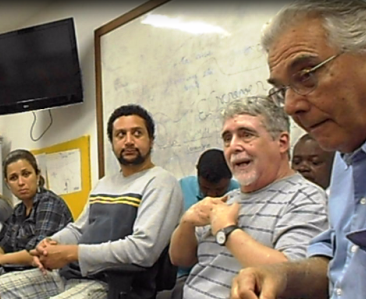
On Thursday, November 17th there was an important meeting in Rocinha’s Sports Complex (Complexo Esportivo da Rocinha) at 6:30PM. The meeting was organized by the Community Board for Rocinha, São Conrado and Gávea (Câmara Comunitária da Rocinha, São Conrado e Gávea). The Community Board is a social movement that was formed in early 2011 with the aim of following activities in Rocinha and holding the government accountable for the many development practices and policies affecting these three bordering neighborhoods. The Board has legislative deliberating powers through two previously selected coordinators. There were more than 60 people at the meeting, with representatives from all three neighborhoods – although roughly 80% were from Rocinha. There are eight thematic groups that make up the Community Board – Education, Health, Sports and Leisure, Urbanism and the Environment, Work and Income, Communications, Tourism. The following institutions and entities were present – Firjan, UPP Social, Viva Rio, Sebrae, Rio’s Secretary for Human Rights from the 27th Administrative Region, Instituto Embelleze, Cras Rinaldo Delamare, Fundação Bento Rubião, Complexo Esportivo da Rocinha, Instituto Reação, Hotel Windsor, Escritório de Arquitetura Toledo, The Municipal Director of the Secretary for Social Service and a couple dozen others. Andrea Gouvêa, the City Council Women (PSDB) representing Gávea was there, as well as Ruben César, the founder and director of the mega NGO – Viva Rio. Everyone was adding their two-cents on the recent events involving the expulsion of the drug traffickers and the installation of the UPP.

The most important person present (in regards to Rocinha’s major infrastructure development since 2004) was Carlos Luis Toledo, henceforth Toledo. Toledo is a well-known architect who has been active in Rocinha since the 1980s, but particularly so as of 2004. After Rocinha’s Three Day War in April of 2004 (when the controlling drug faction switch from the CV to the ADA) Toledo, alongside dozens of residents from Rocinha and São Conrado, created the crucial but barely known “Socio-Spatial Master Plan for the Sustainable Development of Rocinha.” Toledo is a highly gifted urban planner, but he is also humble and humorous, and literally beloved in Rocinha. The original Master Plan considered everything from the infrastructure to culture to the essential socioeconomic needs of the community. It is a wonderful document(s). In reality the Master Plan exists in a various formats and similar versions, but the original version was well over 1000 pages. VIEW A PRESENTATION SLIDE SHOW OF THE MASTER PLAN HERE
Up until 2006 it seemed that the Master Plan, with the full scale participation of local residents, would redefine Rocinha is very positive ways.


Problems began to emerge when the state government, under then candidate for Governor, Sérgio Cabral caught whiff of this now classic document. The Master Plan soon became a pivotal aspect of his 2006 electoral campaign. The original Master Plan is considerably different than what the state government ended up implementing in the community. The reasons for this are complex, but the initial 60 or 70 million the federal and state governments had pledged to Rocinha quickly dried up. By 2007 Cabral was governor and all of the funds for the Master Plan were used. This is when the Federal Government really got involved and when PAC 1 in Rocinha was born. It is crucial to understand that PAC 1 in Rocinha, as well as the PAC 1 slum upgrading programs in Complexo do Alemão and Manguinhos, were born out of Rocinha’s Master Plan – which residents crafted with Toledo after the Three Day War in 2004.
PAC 1 soon became a key political tool for Cabral to guarantee his reelection in 2010, a process he began as early as 2008. The federal government had now officially launched PAC in Rocinha, with a budget of close to R$ 300 million, or about $ 170 million dollars. PAC 1 (then simply known as PAC because there was no PAC 2) became equally important for Lula, or rather his protégé President Dilma Rousseff.

By 2007 Toledo had also been asked to design the PAC 1 slum upgrading plans for Complexo do Alemão and Manguinhos. He declined the offer. Toledo told Mundo Real in an interview that working in Rocinha was already approaching a work overload and he wanted to dedicate himself entirely to one project. To make a long story short, the hundreds of people in Rocinha, São Conrado and Gávea, who were integral to the original Master Plan, are very disillusioned with the results. Why has PAC 1 been a disappointment to so many of the residents and outsiders active in community development in Rocinha? To begin with, the previously omnipresent drug trade and the HIGHLY corrupt Resident’s Association certainly interfered in negative ways. Despite the local level corruption, the state government of Rio de Janeiro also made short cuts, cost cuts and significant changes to the original Master Plan. Just to name a couple crucial changes, the original Master Plan included a full scale hospital (see photo above) and not a semi-functional UPA (a mini-hospital that is a mere step up from a community health clinic). Another significant difference is that the original Master Plan also included very specific objectives for the Laboriaux section of Rocinha. The original Master Plan did not call for the eviction of Laboriaux but instead would have transferred dozens of Laboriaux’s residents from areas at risk (of landslide and other natural disasters) to new housing complexes that were to be built in safer areas of Laboriaux.  Also included for Laboriaux were drainage, sewage and slope infrastructure plans. Under the modified PAC 1 plans NOT A SINGLE PROJECT was implemented in Laboriaux. To be fair, improvements were made in Rocinha as a result of PAC 1, but not nearly to the degree or in the participatory way residents and civil society had hoped for. The UPA, for the most part, has been a positive thing for the community. Widening Rua Quatro was fundamental – although to cut costs the state (EMOP) decided to widen the side of the once narrow alleyway that least needed to be altered. The much more critical side of Rua Quatro remains cramped and damp and Tuberculosis is still rampant. Despite the cost cutting and corrupt politics, the widening of Rua Quatro has been a positive thing for Rocinha.
Also included for Laboriaux were drainage, sewage and slope infrastructure plans. Under the modified PAC 1 plans NOT A SINGLE PROJECT was implemented in Laboriaux. To be fair, improvements were made in Rocinha as a result of PAC 1, but not nearly to the degree or in the participatory way residents and civil society had hoped for. The UPA, for the most part, has been a positive thing for the community. Widening Rua Quatro was fundamental – although to cut costs the state (EMOP) decided to widen the side of the once narrow alleyway that least needed to be altered. The much more critical side of Rua Quatro remains cramped and damp and Tuberculosis is still rampant. Despite the cost cutting and corrupt politics, the widening of Rua Quatro has been a positive thing for Rocinha.
It is important to recall that since 2004 there have been significant changes in the government’s ‘handling’ of Rocinha, and other favelas (especially in Rio de Janeiro). The reasons for this are multifaceted and contentious. Some believe that this new and serious focus on urban poverty and violence, especially in Rio de Janeiro, is a result of the progressive policies/programs that began with Lula, and continue with Dilma, and which have focused significantly more on tackling poverty, inequality and violence. Critics often counter that this is all mainly a façade, not much more than large scale clientelism along with publicity stunts to make Brazil, and especially Rio, look good in light of the string of large and lucrative sporting events that began in 2007 with the Pan American Games, and will continue up to the 2014 World Cup and 2016 Olympics. The truth is probably somewhere in-between. One thing is certain, however, there is much more money available in Brazil for development projects and programs than there was in the past, even a decade ago. Some of this is purely luck (such as the discovery of massive offshore oil reserves) and some is a result of good fiscal, socioeconomic and other public policies. The amount of public money freed up for development in Rocinha since 2007 has now surpassed 1 billion reais, or over six hundred million US dollars. This is an incredible and previously unheard of amount of public money allocated to a single favela community. The development resources have been largely freed up by the federal government, followed by the state government, and lastly the City of Rio de Janeiro. It would not be fair to Rocinha’s residents to suggest that this all of this money has been invested in the community because millions have disappeared.
Of the roughly 280 million promised from (PAC 1) literally millions have vanished while the projects still remain about 35% unfinished.
On Thursday night Toledo had a lot to say. He voiced his concern and sadness regarding how PAC 1 remains was unfinished, despite the fact that the R$ 280 million was completely used up while 35% remains incomplete. PAC 2 is soon to start. Toledo addressed the Master Plan and the difficulty in implanting Rocinha’s PEU, or Project for Urban Structuring (see http://www2.rio.rj.gov.br/smu/paginas/peu.asp). A PEU is a set of official rules that are governed by policies and practices established to guide the physical development of bordering urban neighborhoods so that they share similar characteristics. This is a way, in theory, of reducing inequality because if a PEU was successfully completed in favela community like Rocinha it would mean that Rocinha would have to share similar physical characteristics to its affluent neighbors in São Conrado and Gávea. Rocinha’s PEU was a fundamental part of the Master Plan. Toledo also spoke of the teleférico (cable car lift) that will soon begin construction in Rocinha, which in his view is being built for tourists not for residents. Toledo explained that the company supplying the parts is French and all the parts will have to been imported from France.
He was adamant about his opposition to the Teleférico, which he said would consume the majority of over 700 million destined for PAC 2.
He also said that it would require that thousands of residents be displaced during its construction and later for its maintenance. He said that the massive costs of the Teleférico could be better used for finishing some of the PAC 1 projects that remain incomplete and for other cultural and social activities.
Long time community activist Seu Martins agreed. He said “We cannot lose sight of the greater struggle; we cannot let the UPP distract us from all the other fundamental changes taking place in and around Rocinha.” This came just a few days after mayor Eduardo Paes spoke of, for the first time in over a year, evicting half of Laboriaux’s residents. On Monday, one day after BOPE invaded Rocinha, Paes promised that 120 houses (affecting about 500 people) would be removed from Laboriaux. Residents were dumbfounded. What convenient timing! When Bruno Ramos, the district mayor of Zona Sul was contacted he confirmed that the entire side of Laboriaux facing Gávea and Lagoa will be evicted and demolished. This includes the house I rent. This goes completely against what the City has been saying for the last year, that they would only remove a few more houses in areas of extreme risk and start building slope retaining walls in all other necessary areas.
Threatening to remove one side of Laboriaux is a very strategic tactic to divide the community. We believe that it is highly likely that if one side of Laboriaux is removed that it won’t be long before the other side is also evicted.


You must be logged in to post a comment.